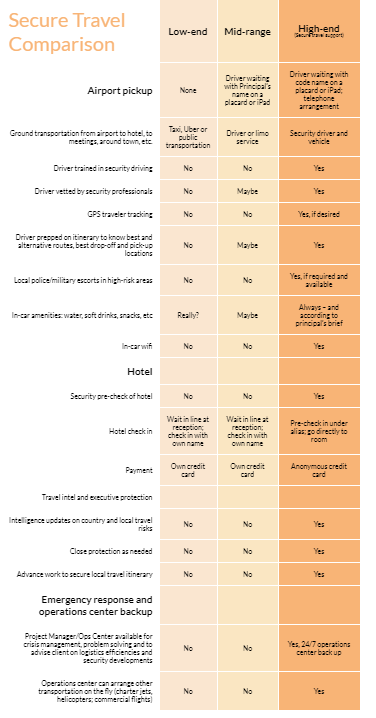In this blog, we take a look at the missing link of executive travel: secure ground transportation that’s at as high a level as first or business class flights and five-star hotels.
Many companies happily pay for first/business class flights or even private aviation to get their top executives where they’re going, then put them up at five-star hotels when they reach their destinations. These standard travel practices are key to keeping execs productive, safe and relatively happy no matter where their travels take them.
Corporate travel policies always have something to say about who flies how and who gets to stay where. Companies rarely pay any attention to what happens between the airport and the hotel lobby – or anywhere else travelers might go while on a trip.
Before we dig into why companies don’t apply the same focus to high-quality, secure local transportation – the missing link in the door-to-door chain of secure, productive travel – let’s examine why corporations prioritize business-class flights and best-in-class accommodations. It’s all about return on investment.
Why companies opt for business class seats and 5-star hotels: ROI
Business people travel to do business, and companies spend money on travel because it pays. According to Certify, a travel expense management company, “for every dollar spent, companies commonly see a $2.90 profit increase and a $9.50 rise in revenue”.
Companies spend money on business class airfare because this pays, too. Principals are able to work easily during flights if they wish, or to sleep comfortably on long-haul flights. Their companies want them to be prepared, rested and sharp when they land.
It’s the same story with hotels. Although businesses can choose from a wide range of accommodations, the highest paid executives tend to stay in the best hotels. Smart companies want their highest-paid travelers to add maximum value on the road, and five-star accommodations enable more productivity and rest than their alternatives. They’re located centrally to save time. Their management and F&B offerings live up to international quality standards. They have all the services, features and business facilities that road warriors expect, so travelers can find pretty much everything they might need under one roof instead of shuttling around town for a gym, meals, meeting facilities, dry cleaning, quick printing, etc.
The expenses are worth it if you do the math. There are cheaper ways to travel, but even corporations with reputations as ruthless cost-cutters spend on good flights and hotels for a reason: The benefits of these time-honored executive travel practices can easily outweigh their costs and thus deliver excellent return on investment.
Caring about people and productivity – and duty of care
All corporations know that increased productivity – from the shop floor to the C-suite – creates competitive advantage. They also know that workloads don’t go away just because people travel.
Business class flights and five-star hotels make it easier to get more done, so more work gets done. Getting a decent night’s sleep on a trans-Pacific flight means execs hit the ground running and go right to work upon landing. Hotel business centers and concierge services are convenient, but they also allow execs to spend more time on what adds value and less time on tasks that make no difference to the bottom line.
Most businesses also understand that heavy travel schedules are tough on employees. Being away from family and friends, dealing with the hassles of time zone changes while staying on top of all the usual responsibilities is a recipe for stress. Companies that recognize this – and try to minimize the stresses of the road by rounding up instead of down in terms of comfort and convenience – are more likely to attract and retain the talent they need.
There’s another reason companies invest in quality travel: employee care.
When people travel for the company, the company has an obligation to prevent foreseeable accidents or health issues and to mitigate predictable risks.
Where door-to-door productivity enhancement, convenience and duty of care for executive travel drive off the road: local transportation
In our experience, what happens on the ground once execs get to where they’re going is rarely given the same scrutiny as flights or hotels. On a good day, some travel departments might arrange for a limo service, but that’s about as far as it goes. In fact, most travelers are left to their own devices when it comes to moving about in the cities and countries they visit.
Although there are providers of high-end, secure travel services in many cities, these are not nearly as well-known as airlines or hotels. Have a look at the table below to see how high-end, secure local transportation stacks up against what usually happens.

As you’ll see in the table above, high-end secure travel support really is a different animal. Principals won’t usually check off every box on every trip, but everyone who buys into part of it has access to all of it.
If you compare columns, you’ll see that the higher the level, the greater the advantages in terms of security, productivity and convenience.
Whether principals make use of a little or a lot depends on destinations and circumstances. A secure driver is usually the minimum, and this alone provides plenty of tangible benefits. As needs evolve, and as companies learn more about their options, they often add more services.
We want our principals to say, “You guys make it easier to travel, so we travel more.” This sums up the ROI of secure travel support as succinctly as possible.























